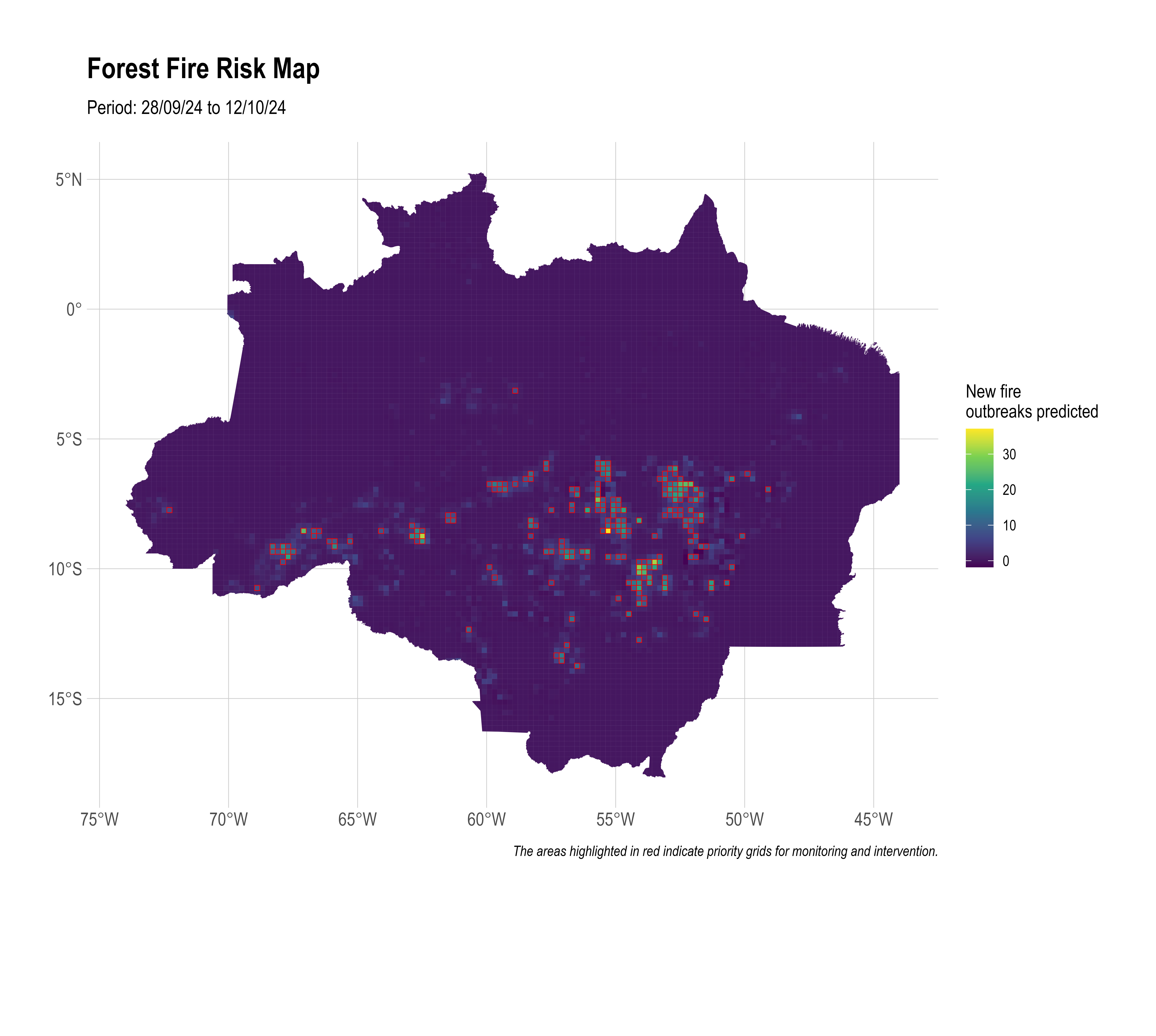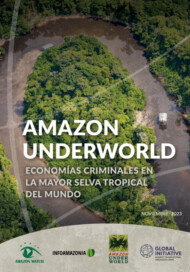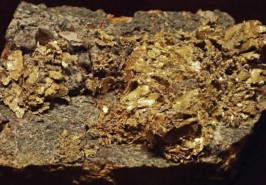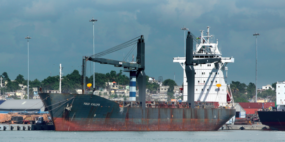Over the past year, a record number of mass fires have occurred across the Amazon basin. Many of them, particularly those in the Brazilian Amazon – which accounts for over 60 per cent of the rainforest’s area – are deliberately set by illicit gold miners or land grabbers looking to clear swathes of forest, highlighting the role of criminal actors in driving the climate emergency. So far in 2024, these fires have destroyed over 11 million hectares of land in the Brazilian Amazon. The devastation has spread to the Peruvian Amazon, where the government declared a state of emergency in September.
The fires have intensified since June, following the onset of the region’s longest and most severe drought on record. Even the moisture-rich vegetation of the rainforest has dried out, allowing the fires to spread uncontrollably. Extreme drought has also caused many of the region’s largest rivers, including the Amazon and the Madeira, to reach historically low levels. Surrounding communities are bearing the brunt of the damage. The fires have stripped away livelihoods, disrupted food supplies and caused the worst air quality ever recorded in the region. Violence is also escalating as illicit actors encroach on their land.
Before this latest crisis, there had been some progress in the Brazilian Amazon’s conservation efforts. In 2023, the deforestation rate had dropped by almost 50 per cent, largely due to President Luiz Inácio Lula da Silva’s revival of environmental protection agencies that had been weakened by the policies of the Bolsonaro government. This progress helped slow carbon emissions, as the rainforest plays a vital role in absorbing CO2. But the current wildfires have reversed these gains, leading to record carbon emissions. In just three months, from June to August 2024, the region is estimated to have released the equivalent of 31.5 million tonnes of CO2, almost as much as Norway’s annual emissions – a 60 per cent increase from the same period in 2023.
Most of the fires have broken out in indigenous territories. The main hotspot is the Kayapó territory in the Brazilian state of Pará, which, not coincidentally, is one of the areas most affected by illicit gold mining. In early September 2024, Brazil’s environmental and federal law enforcement agencies launched a joint operation in the area that revealed that small-scale miners were starting fires in the area to clear sites for illegal mining. The operation uncovered five camps that were used as logistical bases for setting fires and launching gold excavations.
Indigenous communities have long used controlled fires on a small scale to sustain their agricultural practices. But in recent decades, criminals have repurposed and expanded these traditional practices to clear public land in the rainforest. They burn down areas of forest to make way for illegal mines, cattle ranches or plantations of high-value crops such as soybeans or palm oil. New highways have given criminals access to previously untouched areas of the rainforest.
The land grabbers have amassed enormous wealth from their clandestine land acquisitions and, with it, can exert political muscle. Many occupy influential positions in local governments and the judiciary in the region. In areas where they control large swathes of land, their influence over voters can be considerable. Politicians often turn a blind eye to their destructive activities, knowing they will help secure votes.
Land grabbers also use forest fires as a form of political mobilization. In August 2019, in what became known as the Dia do Fogo (the Day of the Fire), they orchestrated a mass outbreak of forest fires in south-eastern Pará to show their support for Bolsonaro’s anti-environmentalist agenda. Smoke from those massive fires spread throughout Brazil, becoming a symbol of the environmental destruction driven by criminal networks operating in the region – and with the blessing of political interests.
The Amazon’s climate crisis has therefore been part of a vicious cycle fuelled by criminal economies and sanctioned by elite corruption. Illicit activities lead to environmental devastation, which, in turn, opens up more opportunities for criminal markets to expand.
This now critical situation has spurred the Brazilian government into action. Recognizing that these fires are largely the result of human activities driven by illicit interests, Lula’s administration announced a number of policy measures to address the climate emergency. Among these measures is a decree that increases the fines for starting forest fires, acknowledging that previous lax regulations did little to deter environmental crimes.
However, not all of these measures align with the goals of conservation. Lula’s administration has also approved the construction of a new interstate highway that will connect the cities of Manaus and Porto Velho. The road will cut through the western part of the Brazilian Amazon, one of the last bastions of rainforest, less affected by deforestation. While the government claims the highway will aid humanitarian efforts to mitigate the effects of the climate emergency, this project has been a long-standing demand of politically influential land grabbers, who see it as a gateway to expanding cattle ranching and gold mining into protected rainforest areas.
Rather than achieving its intended purpose, the highway runs the risk of boosting the criminal ecosystem of the Amazon, which has already propelled the rainforest to its current state of ecological devastation. This policy measure illustrates the challenges of implementing conservation measures in a context in which environmental crime interests are rampant. Rather than heeding advice from political actors that defend an anti-environmentalist agenda, government responses to the mass fires should be informed by dialogues with indigenous, riverine and quilombola communities in the Amazon, voices that need to be heard not only because they are on the front line of the climate emergency, but also because they are the most effective stakeholders for conservation efforts in the rainforest.
Following the outbreak of the current fires, the federal government announced a small increase for environmental protection agencies in the 2025 budget. However, these agencies lack personnel and adequate equipment to fight fires across the vast expanse of the rainforest. They need more resources and sustained political support from the Lula administration in order to offset the damaging influence of land grabbers in environmental policy and effectively combat the illicit economies that are causing environmental devastation in the Amazon.
As the Amazon faces mounting threats from mass fires, resources are needed critically. To assist in this effort, the Global Initiative Against Transnational Organized Crime has developed an open-source mapping tool that provides 15-day projections of wildfire spread, available here. The technology uses high-resolution satellite data and machine-learning techniques to forecast new wildfires based on data collected since 2016. The interactive tool also includes the option of overlaying a map of the Brazilian Amazon with its indigenous territories, helping users identify high-risk areas and prioritize responses.

Brincando com fogo
Redes criminosas impulsionam a emergência climática da Amazônia
Ao longo de 2024, foi registrado um número recorde de incêndios florestais na Amazônia. Muitos deles são provocados deliberadamente por garimpeiros e grileiros que buscam desmatar áreas de floresta, uma demonstração do papel importante de agentes criminosos na propagação da emergência climática. Esse cenário é especialmente crítico na Amazônia brasileira, que representa mais de 60% da área total da floresta tropical.
Até o momento, apenas em 2024, tais incêndios destruíram mais de 11 milhões de hectares de terra na Amazônia Legal. A devastação se espalhou para a Amazônia peruana, onde o governo declarou um estado de emergência em suas províncias amazônicas em setembro.
Os incêndios se intensificaram desde junho, na sequência do início da seca mais longa e mais intensa já registrada na região. Até mesmo a abundante vegetação úmida da floresta tropical ressecou, permitindo que os incêndios se espalhassem de forma incontrolável. A seca extrema também fez com que muitos dos maiores rios da região, incluindo o Solimões e o Madeira, atingissem níveis historicamente baixos. As comunidades indígenas, quilombolas e ribeirinhas estão sendo desproporcionalmente afetadas, uma vez que os incêndios destruíram meios de subsistência, interromperam a cadeia de distribuição de alimentos e causaram a pior qualidade de ar já registrada na região. A violência também está aumentando à medida que atores criminosos invadem suas terras.
Antes desta crise, houve progresso nos esforços de conservação na Amazônia brasileira. Em 2023, a taxa de desmatamento havia diminuído em quase 50%. Em grande parte, a redução aconteceu graças à revitalização promovida pelo presidente Luiz Inácio Lula da Silva nas agências de proteção ambiental, anteriormente enfraquecidas pelas políticas do governo do ex-presidente Jair Bolsonaro. Menores níveis de desmatamento contribuíram para reduzir as emissões de carbono, na medida em que a floresta tropical desempenha um papel fundamental na absorção de CO2. Contudo, os atuais incêndios florestais inverteram esse cenário, causando um recorde de emissões de carbono. Em apenas três meses, de junho a agosto de 2024, estima-se que a região tenha liberado o equivalente a 31,5 milhões de toneladas de CO2, quase tanto quanto as emissões anuais da Noruega – o que representa um aumento de 60% em relação ao mesmo período de 2023.
Grande parte dos incêndios ocorrem em territórios indígenas. O principal foco de incêndio é a Terra Indígena (TI) Kayapó, no estado do Pará, que, não por coincidência, é uma das áreas mais afetadas pela mineração ilegal de ouro. No início de setembro de 2024, os órgãos ambientais e a Polícia Federal lançaram uma operação conjunta na TI Kayapó que revelou que garimpeiros estavam incendiando a área para desobstruir locais para mineração clandestina. A operação detectou cinco acampamentos que serviam de base logística para atear fogo e dar início à exploração ilegal de ouro.
Há muito tempo que as comunidades indígenas usam incêndios controlados em pequena escala para sustentar suas práticas agrícolas. Nas últimas décadas, porém, criminosos têm se aproveitado e expandido tais práticas tradicionais com o intuito de abrir caminho para garimpos e para áreas de agropecuária ou plantações de commodities de alto valor, como soja ou óleo de dendê. Novas rodovias deram aos criminosos acesso a áreas da floresta tropical anteriormente intocadas.
Os grileiros têm acumulado enormes riquezas com suas aquisições clandestinas de terras e, com isso, conseguem exercer força política. Muitos deles ocupam cargos influentes nos governos locais e no sistema judiciário da região. Nas áreas em que controlam grandes extensões de terra, a influência deles sobre o eleitorado pode ser considerável. Frequentemente, políticos fazem vista grossa às atividades destrutivas dos garimpeiros, sabendo que elas ajudarão a assegurar votos.
Os grileiros também recorrem a incêndios florestais como estratégia de mobilização política. Em agosto de 2019, no episódio que ficou conhecido como o Dia do Fogo, eles orquestraram uma irrupção de incêndios florestais em massa no sudeste do Pará para demonstrar apoio à agenda antiambientalista de Bolsonaro. A fumaça desses incêndios gigantescos se espalhou por todo o Brasil, tornando-se um símbolo da destruição ambiental causada por redes criminosas que operam na região – e com a aprovação de interesses políticos.
Deste modo, a crise climática da Amazônia tem feito parte de um círculo vicioso alimentado por economias ilícitas e sancionado pela corrupção de elites econômicas e políticas. As atividades ilícitas levam à devastação ambiental, o que, por sua vez, gera mais oportunidades para a expansão dos mercados criminosos.
Essa situação crítica pressionou o governo brasileiro a agir. Reconhecendo que esses incêndios são, em grande parte, resultado de atividades humanas motivadas por interesses ilícitos, o governo Lula anunciou uma série de medidas políticas para abordar a emergência climática. Entre essas medidas há um decreto que aumenta as multas contra incêndios florestais, reconhecendo que as regulamentações anteriores eram brandas e pouco fizeram para dissuadir crimes ambientais.
No entanto, nem todas essas medidas estão alinhadas com os objetivos de conservação. O governo de Lula também aprovou a retomada das obras de uma rodovia interestadual que ligará Manaus a Porto Velho. A estrada cortará a parte ocidental da Amazônia brasileira, onde estão alguns dos últimos redutos de floresta tropical relativamente preservados do desmatamento. O governo afirma que a estrada ajudará nos esforços humanitários de mitigação dos efeitos da emergência climática. Contudo, esse projeto tem sido uma reivindicação de longa data de grileiros politicamente influentes, que o veem como uma porta de entrada para a expansão da pecuária e do garimpo de ouro em áreas protegidas da floresta.
Em vez de atingir o objetivo pretendido, há risco de que a rodovia fortaleça o ecossistema do crime na Amazônia, que já está ajudando a impulsionar a floresta tropical ao seu estado atual de devastação ecológica. Essa política pública ilustra os desafios da implementação de iniciativas de conservação em um contexto no qual os interesses de crimes ambientais imperam. Em vez de acatar os interesses de atores políticos que defendem uma agenda antiambientalista, as respostas do governo aos incêndios em massa devem ser informadas por diálogos com comunidades indígenas, ribeirinhas e quilombolas na Amazônia, vozes que precisam ser ouvidas não apenas porque estão na linha de frente da emergência climática, mas também porque são as partes interessadas mais eficazes para os esforços de conservação.
Após o desencadeamento dos atuais incêndios, o governo federal anunciou um pequeno aumento na verba dos órgãos de proteção ambiental no orçamento de 2025. No entanto, esses órgãos carecem de agentes e equipamentos adequados para combater incêndios em toda a vasta extensão da Amazônia Legal. Esses órgãos necessitam de mais recursos e apoio político contínuo do governo de Lula para compensar a influência perversa dos grileiros na política ambiental e combater efetivamente as economias ilícitas que estão devastando a Amazônia.
Uma vez que a Amazônia enfrenta ameaças crescentes de incêndios em massa, recursos para a mitigação de impactos são extremamente necessários. Para contribuir para esse esforço, a Global Initiative Against Transnational Organized Crime (Iniciativa Global contra o Crime Organizado Transnacional) desenvolveu uma ferramenta de código aberto que oferece projeções quinzenais da a propagação de incêndios florestais, disponível aqui. A tecnologia usa dados de satélite de alta resolução e técnicas de aprendizado de máquina para prever novos incêndios florestais com base em dados coletados desde 2016. A ferramenta inclui também um mapa interativo que sobrepõe territórios indígenas e auxilia os usuários a identificar áreas de alto risco, facilitando a priorização de respostas.





